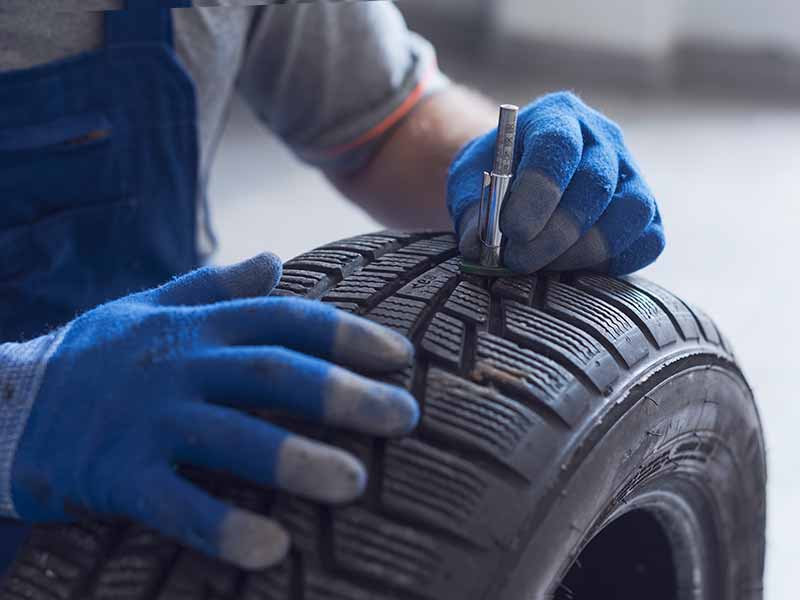There aren’t many, but there are reasons you shouldn’t rotate your tires. There are some that argue whether the benefits of tire rotation are worth the trouble. These arguments tend to fall flat when you realize they mostly focus on tire life and not the complete picture of what tire rotations offer.
Almost all cars and trucks benefit in many ways from having their tires rotated regularly.
When Not To Rotate Your Tires
Vehicles with both directional tires and staggered wheel sets should not have tires rotated. Also, you should never rotate a tire with 4/32″ or less of tread depth left to the rear tires position.
Let’s go over the situations where you shouldn’t have your tires rotated and some important details you should know if you’re considering not rotating your tires.
When Should You Not Rotate Your Tires?
There is one situation in which you shouldn’t rotate your tires:
Directional Tires On Staggered Wheels
Directional tires can only be rotated front to rear. Staggered wheels can only be rotated side to side. If you have both directional tires and a staggered set of wheels, you can’t rotate your tires without causing problems.
Directional Tires
Directional tires are, as the name implies, designed to only spin in one direction. This means that you have to pay attention when mounting them on a wheel and ensure that you have the proper wheels with the direction arrow on the sidewall of the directional tire pointed in the correct direction.
Once your directional tires are mounted onto your wheels, they can only be used on one side of your car or truck. If you were to take that wheel assembly and move it to the other side of your vehicle, it will be spinning in the opposite direction it was designed to spin and you could have some serious traction problems.
Staggered Wheels
Staggered wheels are when you have different size wheels on the front axle than the rear. This is common on many sports cars that are rear wheel drive. Rear wheel drive vehicles have a tendency to oversteer, meaning the rear end of the vehicle has a tendency to slide out under hard cornering.
A wider contact patch can help reduce oversteer and provide better handling for rear wheel drive vehicles. It also has the benefit of helping improve acceleration by providing the drive wheels more traction when launching.
Staggered wheels can not be rotated front to rear and must be rotated side to side. The wheels are designed to only be used on the front or the rear and are not interchangeable. For clarity, it is possible to run slightly different sized tires front and rear without the wheels actually being different sizes, although the amount of difference would be minor.
Staggered Tire Example
The rim on the rear has a much wider lip to accept the wider rear tires.

Why Would You Not Rotate Tires?
Aside from a situation where you physically can’t rotate your tires, some people debate the benefits of tire rotation.
The truth is, for some conservative drivers with conservative suspension geometry, there may not be a lot of benefit. For many though, there is enough benefit to justify the effort, especially if you’re having other maintenance services performed at the same time.
There are several benefits to tire rotation beyond simply extending the life of your tires. One of the most important is maintaining your tire manufacturer’s warranty. A tire warranty can provide you with a discount on a new set of tires if they don’t meet the guaranteed mileage as long as you have your tires rotated according to the manufacturer’s requirements to maintain the warranty.
Why Does BMW Not Recommend Rotating Tires?
BMW makes driver-oriented vehicles which often feature staggered wheel and tire assemblies. Their cars and trucks are usually rear wheel drive vehicles or all wheel drive vehicles with a rear bias. This makes them ideal candidates for staggered wheel sets.
BMWs also often feature directional tires. Not always, but it isn’t uncommon for sports-oriented tires to be directional.
While I don’t own a BMW, I will admit that they do live up to their tagline of the “Ultimate Driving Machine”. Handling and balance are superior to most other cars I’ve driven.
Some BMW dealers still recommend tire rotation if the vehicle doesn’t have directional tires or staggered wheels. While it probably is a little self serving on the part of the dealership to get customers returning on a regular schedule so they can pitch other services, I think it’s wise to rotate your tires if you can.
Is It Bad To Not Rotate Your Tires?
It’s not bad to not rotate your tires, but you miss out on the benefits that tire rotation can provide. In addition to extended tread life, maintaining the tire manufacturer’s warranty requirements is important for many to allow them to receive a discount on unrealized guaranteed tire mileage.
One other benefit that I feel gets overlooked is the benefits of having a professional put eyes on you tires regularly to inspect for problems that could be related to tire damage, balance, or alignment. Regular rotation will bring to attention these issues and help you stay ahead of the problems associated with them.
Is There A Wrong Way To Rotate Tires?
There are tire rotation patterns that are optimized for front wheel drive, rear wheel drive, and all wheel drive cars and trucks, but that doesn’t mean a rear wheel drive vehicle wouldn’t see some benefit from using a rotation pattern optimized for a front wheel drive vehicle.
Generally, any tire rotation is better than no tire rotation, unless it deals with moving directional tires to the wrong side of the vehicle, or moving staggered wheels or tires to the wrong axle.
Simply rotating tires side to side will have the least positive benefit to tire life. Front to rear rotation patterns better improve tire wear due to the larger difference in tread wear between front and rear axles.

Why Won’t They Rotate My Tires?
The most common scenario where a tire shop will refuse to rotate your tires is when there is not enough tread depth left on one or more of the tires to ensure that you will be safe.
Some car owners mistakenly believe that if the wear bar in the gap between tread lugs hasn’t been reached yet, the tire is safe. Wear bars are reached when you only have 2/32″ of tread left. This is actually the point when you shouldn’t use the tires anymore at all.
You should replace your tires when you have 4/32″ of tread left, or double that of the wear bar height. New tires will have 10/32″ of tread wear or more.
Tires don’t work perfectly until they run out of tread depth. The lose ability to shed water as they wear down and will slowly lose their ability to grip in wet weather. Once they reach 4/32″ of tread There is very little depth left for water to be shed and hydroplaning starts to become a real concern.
Some tire shops will not rotate tires at 4/32″ or will not rotate a tire with this little tread depth to the rear due to safety concerns.
What Happens If You Don’t Rotate Your Tires?
Tires usually simply wear out more quickly and your tire warranty will be voided. Tire wear problems that are symptoms of poor alignment or balance can go unnoticed or addressed.
Tire balance and alignment shift over time. Potholes and curb strikes wear on suspension components can push alignment out of spec. Bent wheels and tire damage can affect tire balance and safety. Tires also can drift out of balance from simple wear over time.
Why Are You Supposed To Rotate Your Tires?
Tire rotation helps even out tire wear patterns and extends the life of tires. Sometimes this can be a dramatic difference, although this is honestly more an exception than a rule.
Tire manufacturers will usually not honor a tire warranty if you can’t prove that you’ve properly maintained the tires to their requirements. Usually this includes tire rotation before a specific amount of mileage is reached.
Final Thoughts
Swapping your front tires and rear tires will benefit front wheel drive vehicles and rear wheel drive vehicles the most. When only one axle propels a vehicle forward, those tires tend to take a beating and the overall set can have much more extended life by simple regular tire rotations.
Scheduling your tire rotations at the same time as other vehicle maintenance services can alleviate the concerns of many and make tire maintenance more convenient.
References
Below are some links you may find helpful when learning about tires






